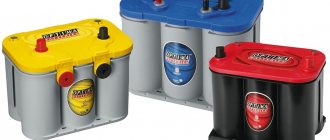The gel battery is a maintenance-free sealed power source. Used in various electrical devices, most often in transport. It is produced using GEL technology. People call them helium batteries. This does not mean that they contain helium. The electrolyte simply has a jelly-like form.
Such energy storage devices have many advantages over lead-acid and AGM batteries. Due to their sealed design, they can be used in any position. Damage to the housing does not result in liquid leakage. Resistant to vibrations and have a high charge and discharge cycle. Recharging occurs quickly and no gases are released. Therefore, this type is considered the most reliable.
Technical characteristics of the gel battery
This section will provide the main parameters.
What is Gel?
This is an electrolyte fixed in a gel. Gel technology is based on silicon dioxide. The gel is able to make excellent contact and prevent short circuits between the plates. It's similar to when a sponge absorbs water. So here, too, there is some retention of the contents due to the jelly-like consistency. Thanks to this approach, the plates do not crumble.
This type of battery uses purified lead. It has little resistance. This makes it possible to quickly discharge and charge.
The gel battery is made in a non-separable case. Under no circumstances should it be disassembled. The microclimate may be disrupted and gas will escape, protecting the plates from oxidation. This gas also contributes to 100% performance. If damaged, the battery will function. The truth is 30 percent worse. And the service life will naturally be shortened.
Approximate parameters of gel batteries
- Capacity from 20 – 200 A/h.
- Current strength.
- Rated voltage 12 volts.
- Weight depends on the capacity, usually starting at 5 kg.
- Size. Each model has its own. DELTA GEL 12-20 Length 158, width 77 mm, height 167 mm.
- Working temperature.
- Service life 5 – 12 years.
- The maximum charging current for some models reaches 30 amperes.
The starting current or maximum discharge current is in the region of 550 - 950 A.
Marking of gel batteries
On the label you can find the most standard designations. First of all, this is data on voltage in volts, capacity in ampere hours and type. You can understand that this is a gel battery by the inscription GEL.
There are 4 types of designations:
- Russian.
- Asian.
- European.
- American.
Sometimes you can see such an inscription 60 A/h. This means that the battery can generate a current of 1A for 60 hours.
In addition to this inscription, you can find the discharge current or starting current. For example, a gel battery with a cranking current of 200 amps will not be able to start a diesel engine. But a current of 500 amperes can pull almost any engine even in cold weather. If the battery is working, of course.
In addition to the above, the manufacturer leaves information about the production date and service life on the case. You can also notice the manufacturer's company.
Below, using an example of a Delta brand battery, the main markings are shown.
Gel battery life
Usually it is 10 years. Sometimes the manufacturer may claim 15 years. The minimum term is 5 years. But it can also be identified by the number of charge and discharge cycles.
| Cycles | Discharge percentage |
| 350 times | 100% |
| About 550 | 50% of rated capacity |
| About 1200 | 30% |
Strict adherence to operating conditions will allow the Helica to operate for more than 7 years.
The main reasons for the rapid wear of a gel battery
- Repeated undercharging of the battery.
- It takes a long time to disconnect from the charger when the battery is already charged.
- Sudden and frequent temperature changes. Especially the drop to -30 and the increase to +50. High temperature causes acceleration of corrosion of the current of the conductive plates.
Why is a gel battery good for motorcycles?
Before we talk about the advantages of gel batteries, we should honestly mention that their price is sometimes several times higher than the cost of cheaper lead-acid batteries. Of course, motorcyclists may still resort to buying cheaper options to this day.
But before making a final decision, it won’t hurt to familiarize yourself with why a gel battery is most preferable as a motorcycle battery or as a scooter battery:
- How to maintain such a battery? This is not required. The battery plates are “sealed” in a gel-like substance. This consistency is obtained due to the addition of silicon oxide to the electrolyte. Serviced or partially serviced batteries are usually lead-acid and require a more careful attitude with regular addition of distilled water or pure electrolyte. Due to their composition, gel batteries do not need this.
- They are more durable and safe , and have increased resistance to mechanical damage. In conditions of fast driving and increased risk for a motorcyclist on the roads, this can even be a salvation. Also, charging gel batteries for scooters is less troublesome than the same process of charging liquid acid batteries.
- Due to the fact that the electrolyte in them is in the form of a gel, it will not leak through its body and will not spill out during sharp turns, bends and even collisions on the highway. It is no coincidence that gel batteries were first actively used in the aviation sector. They don’t care about regular changes in the vehicle’s position, neither in the air, nor on water, nor on the ground - a charged power source will not explode or leak.
- Gel batteries are capable of operating in any extreme conditions with much greater productivity than even improved acid analogues . The range of temperatures that they can withstand is very wide: from -60 to +50°C.
- They are not afraid of deep discharge and are easily “brought to life” by the usual charging method . Even if the motorcycle or moped has been standing for a long time without use. If the battery cannot be woken up, it will be useful to learn how to restore a gel battery. It is noted that such batteries can maintain their optimal capacity much longer when not in use than any other . There is evidence that even after two years of non-use, such a battery easily restored its potential.
- If handled with care, and if gel batteries for scooters and other vehicles are charged regularly and correctly, the service life of gel batteries can be up to 10 years .
- Due to the stable retention of capacity, any gel battery can be used immediately after purchase . There is no need for additional recharging. This is important for motorcyclists who value the fastest solution to certain technical problems.
- If the battery case is damaged due to an emergency collision with any object, the silicon oxide added to the sulfuric acid will minimize the release of harmful gases , and the gel will not leak out of the case . This reduces the possible risk of fire to zero.
So, there are quite a lot of incentives to consider gel batteries as motorcycle batteries. However, before buying this particular option, you need to familiarize yourself with those features that may cause certain inconvenience to the owner.
Gel battery device
To create this battery, GEL technology is used. It allows the electrolyte not to spread and maintains the EMF of one dedicated cell at a level of 2.1 volts.
Below is the structure of 12V gel batteries.
There are 2 types of similar batteries on sale: with electrodes in the form of spirals and plates.
The composition of the gel battery includes:
- Positive and negative stigma.
- Frame.
- Separator.
- Support prisms.
- Cover.
- Lead grate.
- Sealed valves.
- A special electrolyte mixed with silicon particles or other substance. This allows it to be gel-like. Silicon dioxide does not react with sulfuric acid. Therefore, it does not interfere with the performance of the battery as a whole.
- Gas exhaust system.
Between the electrodes there are gaps in which separators are located. They are made of fiberglass. This material has small pores that prevent the pasty liquid from spreading. This design improves battery performance. Tightly folded electrode plates also increase efficiency. They are made of high quality lead.
Principle of operation
The process of generating electricity is based on the interaction of the electrolyte with the plates. In this battery, the energy liquid is acid, which contains a silicone compound. It allows you to turn it into a gel. Distilled water is also available.
When a battery operates, some plates ALWAYS oxidize, others are ALWAYS restored!
How to test a gel battery at home?
A regular tester/multimeter will do for this. Verification algorithm:
- Remove the battery cover, if equipped.
- Disconnect the negative wire from the terminal, and then the positive one.
- Switch the measuring device to voltage measurement mode.
- Carefully observing the polarity, connect the probes of the device to the battery contacts.
- The voltage level will be displayed on the indicator.
If U is equal to 12.8-12.9 volts, then it is normal.
12.6 V – indicates that charging is about 75%. A voltage of 12.3 V indicates that recharging will be required because the battery is 50% charged.
Checking with a load fork
At the time of purchase, the battery is checked with a load fork. This device takes some of the current. As a result, the voltage should not drop below 9 volts. Test time is 15 seconds according to Russian GOST and 30 seconds according to the Euro standard. After disconnecting the test plug, the voltage should restore to 12.6-12.7 volts.
If, after checking, the indicators do not become equal to the required voltage and the voltage is less than 9 volts, then we do not recommend using such a battery. It has probably been in storage for quite some time without being used. And its capacity has decreased significantly.
Thus, each consumer can check the functionality of the GA.
Recovery
In order to revive such a battery, you need to remove the covers from the battery compartments and start pouring distilled water into each jar. Despite the fact that these batteries are classified as maintenance-free, it is always possible to remove their covers. Add water using a syringe, two milliliters into each “jar.” After half an hour, remove excess water with a rubber bulb - it should slightly cover the plates. Close the battery, place a weight on top (to prevent the caps from being knocked out by high pressure) and start charging.
You can revive the battery by applying a voltage of more than 14 volts. To restore it, at the beginning of charging you will need a voltage of at least 15 volts. It is necessary to keep it on charge for about 14 hours, first waiting for the moment when it begins to consume current. If the battery does not respond to a voltage of 15 volts, it can be raised to 30. When the battery finally “swings”, after two or three such cycles, charge it in the usual way - with a current of 10 percent of its capacity, reducing the voltage to 14 volts.
However, many experts do not recommend reconditioning batteries of this type. Often the effect is only temporary.
Types of gel batteries
Essentially there are no special options. The only thing is that they can be classified by manufacturer, voltage and manufacturing option.
Performed in 2 options:
- Spiral - the plates are helical. The separator, together with the electrolyte, is concentrated in the middle of the entire spiral structure.
- Lamellar - a jelly-like filler is located between the flat plates as in a conventional battery.
According to the voltage level there are:
- 24 volt. They are intended for trucks and special vehicles.
- 12 V. These batteries are great for motorcycles, cars, boats, snowmobiles, ATVs, etc.
- 6 volt battery. Required in scooters, buggies, mopeds and other small equipment.
The capacity of such power supplies reaches 200 A/h.
Manufacturers will be discussed towards the end of the article.
Pros and cons of gel batteries
What is good about this energy source? Below we will discuss the main advantages and disadvantages of gel batteries.
pros
- In any position the density will be the same.
- Environmentally friendly.
- The gel does not allow gas to pass onto the surface of the battery.
- Has a long service life.
- Withstands deep discharge. The gel helps prevent the formation of lead oxide crystals. Which can block the transmission of current. But you should not create a situation in which the 12 volt gel battery runs out too much. This reduces service life.
- Small size. This is achieved by a spiral arrangement.
- Holds a charge for a long time.
- Easy to maintain.
- Less sensitive to additional powerful vehicle equipment.
- They can reach up to 1000 charge-discharge cycles.
- Able to regenerate itself after using up its supply! This especially happens due to long attempts to start the engine. Therefore, they are sometimes called traction gel batteries or starter batteries.
- There is almost no risk of the plates falling off.
- No need to add distilled water.
- Service life more than 7 years.
- The dependence of electrolyte density on the degree of charge is rather weaker than that of other batteries.
- You can't charge it for a long time.
- Low internal resistance 3-4 mOhm. The rate of current release depends on it.
- Weakly susceptible to sulfation.
- Charges quickly due to the use of fast lead in the design.
- You can use a gel battery indoors. It will not emit gas.
The gel envelops the lead plates and thereby prevents them from falling off. As a result, the discharge itself and the risk of internal short circuit are reduced.
Gases formed inside do not escape outside. They form into bubbles. This allows the housing to be completely sealed. Over time, gas will accumulate and expand the housing. Therefore, manufacturers took care of this and equipped the housings with special valves. By opening them, you can release excess pressure without spilling liquid.
Due to the completely sealed housing, these batteries are also called maintenance-free lead-acid batteries.
Minuses
- Poorly withstands excess charge. As a result, service time may be reduced. The on-board network voltage must be stabilized. A gel battery with a nominal voltage of 12.6 volts cannot be charged with a voltage of 14.5 V.
- High price. Usually it ranges from 600 – 77,000 rubles. It all depends on the company, capacity and voltage. A cheap gel battery can hardly be found today.
- Poor resistance to low temperatures. In severe frosts, they lose their charge more than conventional acid batteries. Becomes more fragile.
- You will have to check the charge level frequently.
- Sudden voltage surges reduce service life.
- Charging current limitation. The optimal current for Gel batteries is 10% of the capacity in A/h.
- If you use the battery at very high temperatures, the electrolyte will liquefy. This process is irreversible.
- Be afraid of a short circuit. For this reason, they may even fail.
- The regulator relay can kill it if the voltage is greater than 14 volts. The gel will simply melt.
- Sometimes you have to buy additional protective stamps with a control relay. This will prevent the battery from experiencing a voltage surge above normal.
What are the disadvantages of gel batteries?
They have much fewer disadvantages than advantages. They can most likely be called characteristic features that should be taken into account when purchasing.
As already mentioned, their price is much higher than that of other batteries - precisely because of their durability and increased safety. They are more demanding on charging conditions and are less tolerant of voltage and current changes than their acid analogues, which are more resistant to them. When purchasing a gel battery, it is important to immediately acquire a charger suitable for it, always with adjustable current.
How to maintain a gel battery
Some consumers leave negative reviews about these types of batteries. Usually they are associated with the fact that the gel melts and the performance of the device drops. But here most people forget about the operating conditions that are given below. If they are violated, the gel battery will not last long.
The gas that is generated inside the battery does not escape outside. Therefore, you don’t have much control over the cleanliness of the holes. Under poor temperature conditions, for example, in frost, the capacity sags by 19%. It's not too much.
It does not require special care. The main thing is not to overcharge or overheat it. Wipe the surface from dust and moisture. Make sure nothing causes a short circuit. This battery is not particularly demanding. He will be able to start the car even after sleeping on the shelf for 3 years.
Conditions for storing and operating gel batteries
These devices are not particularly fancy, but some rules must be followed.
- Overcharging should not be allowed. The voltage should not exceed 14.4 volts. Otherwise, the electrolyte begins to boil away. This leads to damage to the battery.
- It should be stored in a temperature range from -35 to +50 degrees Celsius. This period should not exceed 6 months.
- Although the manufacturer reports that deep discharge does not harm, it is better not to let it get to that point.
Routine care of a motorcycle gel battery
Despite the fact that the body of the gel battery is sealed, it is necessary to ensure that as little dirt and dust as possible gets on it. special attention to the terminals to prevent oxidation. That's all the maintenance a gel battery needs. Read more about why battery terminals oxidize →
As already mentioned, check the current voltage level in the battery from time to time so as not to miss the moment when it will already require maximum charging. In addition to “major” charging, which lasts 10-12 hours, the battery must be periodically recharged once every two months . Especially if the motorcycle is used constantly. These are the basic technical recommendations on how to charge a gel battery for a scooter or motorcycle correctly.
If you do not use the motorcycle in winter, you can remove the battery from it, clean the dirt with a slightly damp cloth, wipe dry and store at room temperature.
As you can see, a gel battery for a motorcycle, despite its rather high cost compared to others, is one of the best options. Especially when it comes to extreme driving. With proper care and knowledge of how to charge a motorcycle battery correctly, it will pay for itself very quickly. And the absence of the need to add electrolyte to it, along with the prospect of maximum safety, may become an additional incentive to purchase it.
Charging the gel battery
A regular charger will not work for these types of batteries. You need to use one where it is possible to adjust the current and voltage. Otherwise, the energy source may be damaged.
Gel battery charging algorithm
- Unscrew the plugs.
- Set the charger to the desired voltage and zero current.
- Connect the charger terminals to the power source, observing the polarity.
- Configure the charger current parameters.
- Monitor your indicators periodically. Don't leave the battery alone!











